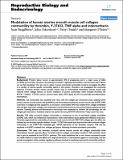| dc.contributor.author | Morrison, John J. | en |
| dc.contributor.author | Smith, Terry | en |
| dc.contributor.author | O'Brien, Margaret | en |
| dc.contributor.author | Fitzgibbon, Joan | en |
| dc.date.accessioned | 2009-03-20T16:27:37Z | en |
| dc.date.available | 2009-03-20T16:27:37Z | en |
| dc.date.issued | 2009-01-08 | en |
| dc.identifier.citation | Fitzgibbon J, Morrison JJ, Smith TJ, O'Brien M; Modulation of human uterine smooth muscle cell collagen contractility by thrombin, Y-27632, TNF alpha and indomethacin; Reproductive Biology and Endocrinology 2009, 7:2 (8 January 2009) | en |
| dc.identifier.uri | http://hdl.handle.net/10379/121 | en |
| dc.description.abstract | Background: Preterm labour occurs in approximately 10% of pregnancies and is a major cause of infant
morbidity and mortality. However, the pathways involved in regulating contractility in normal and preterm labour
are not fully elucidated. Our aim was to utilise a human myometrial contractility model to investigate the effect
of a number of uterine specific contractility agents in this system. Therefore, we investigated the contractile
response of human primary uterine smooth muscle cells or immortalised myometrial smooth muscle cells
cultured within collagen lattices, to known mediators of uterine contractility, which included thrombin, the
ROCK-1 inhibitor Y-27632, tumour necrosis factor alpha (TNF alpha) and the non-steroidal anti-inflammatory
indomethacin.
Methods: Cell contractility was calculated over time, with the collagen gel contraction assay, utilising human
primary uterine smooth muscle cells (hUtSMCs) and immortalised myometrial smooth muscle cells (hTERT-HM):
a decrease in collagen gel area equated to an increase in contractility. RNA was isolated from collagen embedded
cells and gene expression changes were analysed by real time fluorescence reverse transcription polymerase chain
reaction. Scanning electron and fluorescence microscopy were employed to observe cell morphology and cell
collagen gel interactions. Statistical analysis was performed using ANOVA followed by Tukey's post hoc tests.
Results: TNF alpha increased collagen contractility in comparison to the un-stimulated collagen embedded
hUtSMC cells, which was inhibited by indomethacin, while indomethacin alone significantly inhibited contraction.
Thrombin augmented the contractility of uterine smooth muscle cell and hTERT-HM collagen gels, this effect was
inhibited by the thrombin specific inhibitor, hirudin. Y-27632 decreased both basal and thrombin-induced collagen
contractility in the hTERT-HM embedded gels. mRNA expression of the thrombin receptor, F2R was up-
regulated in hUtSMCs isolated from collagen gel lattices, following thrombin-stimulated contractility.
Conclusion: TNF alpha and thrombin increased uterine smooth muscle cell collagen contractility while
indomethacin had the opposite effect. Thrombin-induced collagen contractility resulted in F2R activation which
may in part be mediated by the ROCK-1 pathway. This study established the in vitro human myometrial model
as a viable method to assess the effects of a range of uterotonic or uterorelaxant agents on contractility, and also
permits investigation of the complex regulatory pathways involved in mediating myometrial contractility at labour. | en |
| dc.format | application/pdf | en |
| dc.language.iso | en | en |
| dc.publisher | Springer | en |
| dc.rights | Attribution-NonCommercial-NoDerivs 3.0 Ireland | |
| dc.rights.uri | https://creativecommons.org/licenses/by-nc-nd/3.0/ie/ | |
| dc.subject | Muscle contractility | en |
| dc.subject | Uterine contractility | en |
| dc.subject | Indomethacin | en |
| dc.subject | Thrombin | en |
| dc.subject.lcsh | Uterus Contraction | en |
| dc.subject.lcsh | Indomethacin | en |
| dc.subject.lcsh | Thrombin | en |
| dc.subject.lcsh | Labour (Obstetrics) | en |
| dc.subject.lcsh | Muscle contraction | en |
| dc.title | Modulation of human uterine smooth muscle cell collagen contractility by thrombin, Y-27632, TNF alpha and indomethacin | en |
| dc.type | Article | en |
| nui.item.downloads | 622 | |


